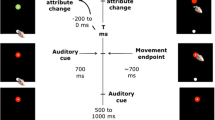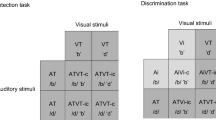Abstract
Previous studies have shown that performing a motor action toward a target decreases the perceptual asynchrony observed in a temporal order judgment (TOJ) of a change in the target’s visual attributes. We examined the temporal limit of this effect and whether this temporal limit can be extended through sensorimotor adaptation. Participants performed a TOJ task related to changes of the position and color of a visual stimulus in a perceptual and a motor task. A fixed change (color or position) occurred 250 or 500 ms following an auditory cue (perceptual task) or the end of a manual reaching action (motor task), whereas the variable change (position or color) occurred randomly within a time window of ±200 ms locked to the fixed change. The points of subjective simultaneity (PSSs) revealed that performing a voluntary action decreased the temporal asynchrony observed in the perceptual task, but only in the 250-ms delay condition. In Experiment 2, the fixed change occurred 1 s after either an auditory cue or the end of a manual reaching action, and the variable change occurred either simultaneously (new sensorimotor contingencies, 60 % of trials) or within a time window of ±200 ms (40 % of trials). The PSSs revealed that temporal asynchrony decreased in the motor task, but only after adaptation to the 1-s delay. Taken together, these data show that voluntary motor action affects the temporal binding of visual attributes for a period of less than 500 ms after the end of the action. Sensorimotor adaptation can nevertheless extend this time interval, at least up to 1 s.




Similar content being viewed by others
Notes
We thank one of the reviewers for having raised the possible role of eye movements in the results obtained in the perceptual and motor tasks.
References
Arnold, D. H., Nancarrow, K., & Yarrow, K. (2012). The critical events for motor–sensory temporal recalibration. Frontiers in Human Neuroscience, 6, 235. doi:10.3389/fnhum.2012.00235
Aymoz, C., & Viviani, P. (2004). Perceptual asynchronies for biological and non-biological visual events. Vision Research, 44, 1547–1563. doi:10.1016/j.visres.2003.12.011
Blakemore, S. J., Frith, C. D., & Wolpert, D. M. (1999). Spatio-temporal prediction modulates the perception of self-produced stimuli. Journal of Cognitive Neuroscience, 11, 551–559.
Blakemore, S. J., Wolpert, D., & Frith, C. (2000). Why can’t you tickle yourself? NeuroReport, 11, R11–R16.
Casarotti, M., Lisi, M., Umiltà, C., & Zorzi, M. (2012). Paying attention through eye movements: A computational investigation of the premotor theory of spatial attention. Journal of Cognitive Neuroscience, 24, 1519–1531.
Cleeremans, A. (2008). Consciousness: The radical plasticity thesis. Progress in Brain Research, 168, 19–33.
Corveleyn, X., & Coello, Y. (2014). Effet de l’action motrice sur les asynchronies perceptives [Role of motor action on perceptual asynchronies]. Psychologie Française, 59, 137–148. doi:10.1016/j.psfr.2013.07.004
Corveleyn, X., López-Moliner, J., & Coello, Y. (2012). Motor action reduces temporal asynchrony between perceived visual changes. Journal of Vision, 12(11):20, 1–16.
Engel, A. K., Fries, P., König, P., Brecht, M., & Singer, W. (1999). Temporal binding, binocular rivalry, and consciousness. Consciousness and Cognition, 8, 128–151.
Engel, A. K., & Singer, W. (2001). Temporal binding and the neural correlates of sensory awareness. Trends in Cognitive Sciences, 5, 16–25.
Flanagan, J. R., & Wing, A. M. (1997). The role of internal models in motion planning and control: Evidence from grip force adjustments during movements of hand-held loads. Journal of Neuroscience, 17, 1519–1528.
Fougnie, D., & Marois, R. (2009). Attentive tracking disrupts feature binding in visual working memory. Visual Cognition, 17, 48–66.
Gauch, A., & Kerzel, D. (2008). Perceptual asynchronies between color and motion at the onset of motion and along the motion trajectory. Perception & Psychophysics, 70, 1092–1103. doi:10.3758/PP.70.6.1092
Goodale, M. A., & Milner, A. D. (1992). Separate visual pathways for perception and action. Trends in Neurosciences, 15, 20–25. doi:10.1016/0166-2236(92)90344-8
Guenther, F. H., & Barreca, D. M. (1997). Neural models for flexible control of redundant systems. Advances in Psychology, 119, 383–421.
Haggard, P. (2005). Conscious intention and motor cognition. Trends in Cognitive Sciences, 9, 290–295.
Haggard, P., & Clark, S. (2003). Intentional action: Conscious experience and neural prediction. Consciousness and Cognition, 12, 695–707.
Haggard, P., Clark, S., & Kalogeras, J. (2002). Voluntary action and conscious awareness. Nature Neuroscience, 5, 382–385.
Hanson, J. V. M., Heron, J., & Whitaker, D. (2008). Recalibration of perceived time across sensory modalities. Experimental Brain Research, 185, 347–352. doi:10.1007/s00221-008-1282-3
Jeannerod, M. (1988). The neural and behavioural organization of goal-directed movements. Oxford, UK: Oxford University Press, Clarendon Press.
Jeannerod, M. (2006). Motor cognition: What actions tell the self: What actions tell the self. Oxford, UK: Oxford University Press.
Jordan, M. I., & Rumelhart, D. E. (1992). Forward models: Supervised learning with a distal teacher. Cognitive Science, 16, 307–354.
Kahneman, D., Treisman, A., & Gibbs, B. J. (1992). The reviewing of object files: Object-specific integration of information. Cognitive Psychology, 24, 175–219. doi:10.1016/0010-0285(92)90007-O
Keizer, A. W., Colzato, L. S., & Hommel, B. (2008). Integrating faces, houses, motion, and action: Spontaneous binding across ventral and dorsal processing streams. Acta Psychologica, 127, 177–185. doi:10.1016/j.actpsy.2007.04.003
López-Moliner, J., & Linares, D. (2006). The flash-lag effect is reduced when the flash is perceived as a sensory consequence of our action. Vision Research, 46, 2122–2129.
von der Malsburg, C. (1995). Binding in models of perception and brain function. Current Opinion in Neurobiology, 5, 520–526.
Miall, R. C., & Wolpert, D. M. (1996). Forward models for physiological motor control. Neural Networks, 9, 1265–1279.
Milner, A. D., & Goodale, M. A. (2008). Two visual systems re-viewed. Neuropsychologia, 46, 774–785. doi:10.1016/j.neuropsychologia.2007.10.005
Moore, J. W., & Obhi, S. S. (2012). Intentional binding and the sense of agency: A review. Consciousness and Cognition, 21, 546–561.
Moutoussis, K., & Zeki, S. (1997). A direct demonstration of perceptual asynchrony in vision. Proceedings of the Royal Society B, 264, 393–399.
Naue, N., Rach, S., Strüber, D., Huster, R. J., Zaehle, T., Körner, U., & Herrmann, C. S. (2011). Auditory event-related response in visual cortex modulates subsequent visual responses in humans. Journal of Neuroscience, 31, 7729–7736.
Nishida, S., & Johnston, A. (2002). Marker correspondence, not processing latency, determines temporal binding of visual attributes. Current Biology, 12, 359–368.
Nowak, L. G., & Bullier, J. (1997). The timing of information transfer in the visual system. In K. Rockland, J. H. Kaas, & A. Peters (Eds.), Cerebral cortex: Vol. 12. Extrastriate cortex in primates (pp. 205–241). New York, NY: Plenum Press. doi:10.1007/978-1-4757-9625-4_5
O’Reilly, R. C., Busby, R. S., & Soto, R. (2003). Three forms of binding and their neural substrates: alternatives to temporal synchrony. In A. Cleeremans (Ed.), The unity of consciousness: Binding, integration, and dissociation (pp. 168–192). Oxford, UK: Oxford University Press.
Parsons, B. D., Novich, S. D., & Eagleman, D. M. (2013). Motor–sensory recalibration modulates perceived simultaneity of cross-modal events at different distances. Frontiers in Psychology, 4, 46. doi:10.3389/fpsyg.2013.00046
Pisella, L., Arzi, M., & Rossetti, Y. (1998). The timing of color and location processing in the motor context. Experimental Brain Research, 121, 270–276.
Rizzolatti, G., Riggio, L., Dascola, I., & Umiltà, C. (1987). Reorienting attention across the horizontal and vertical meridians: Evidence in favor of a premotor theory of attention. Neuropsychologia, 25, 31–40. doi:10.1016/0028-3932(87)90041-8
Roskies, A. L. (1999). The binding problem. Neuron, 24, 7–9.
Schmidt, T. (2009). Perception: The binding problem and the coherence of perception. In Encyclopedia of consciousness (pp. 147–158). San Diego, CA: Academic Press.
Schroeder, C. E., Lakatos, P., Kajikawa, Y., Partan, S., & Puce, A. (2008). Neuronal oscillations and visual amplification of speech. Trends in Cognitive Sciences, 12, 106–113.
Senkowski, D., Schneider, T. R., Foxe, J. J., & Engel, A. K. (2008). Crossmodal binding through neural coherence: Implications for multisensory processing. Trends in Neurosciences, 31, 401–409. doi:10.1016/j.tins.2008.05.002
Stetson, C., Cui, X., Montague, P. R., & Eagleman, D. M. (2006). Motor–sensory recalibration leads to an illusory reversal of action and sensation. Neuron, 51, 651–659.
Tanaka, Y., & Shimojo, S. (1996). Location vs. feature: Reaction time reveals dissociation between two visual functions. Vision Research, 36, 2125–2140.
Tanné, J., Boussaoud, D., Boyer-Zeller, N., & Rouiller, E. M. (1995). Direct visual pathways for reaching movements in the macaque monkey. NeuroReport, 7, 267–272.
Treisman, A. (1999). Solutions to the binding problem: Progress through controversy and convergence. Neuron, 24, 105–125.
Treisman, A. M., & Gelade, G. (1980). A feature-integration theory of attention. Cognitive Psychology, 12, 97–136. doi:10.1016/0010-0285(80)90005-5
Viviani, P., & Aymoz, C. (2001). Colour, form, and movement are not perceived simultaneously. Vision Research, 41, 2909–2918.
Wenke, D., & Haggard, P. (2009). How voluntary actions modulate time perception. Experimental Brain Research, 196, 311–318.
Wolpert, D. M. (1997). Computational approaches to motor control. Trends in Cognitive Sciences, 1, 209–216.
Wolpert, D. M., Ghahramani, Z., & Jordan, M. I. (1995). An internal model for sensorimotor integration. Science, 269, 1880–1882.
Yarrow, K., Haggard, P., Heal, R., Brown, P., & Rothwell, J. C. (2001). Illusory perceptions of space and time preserve cross-saccadic perceptual continuity. Nature, 414, 302–305.
Author note
This study was supported by a grant from the French Research Agency ANR-11-EQPX-0023, FEDER SCV-IRDIVE, and University Lille 3. The authors are grateful to Brendan Cameron for his helpful comments on the manuscript.
Author information
Authors and Affiliations
Corresponding author
Rights and permissions
About this article
Cite this article
Corveleyn, X., López-Moliner, J. & Coello, Y. Sensorimotor adaptation modifies action effects on sensory binding. Atten Percept Psychophys 77, 626–637 (2015). https://doi.org/10.3758/s13414-014-0772-6
Published:
Issue Date:
DOI: https://doi.org/10.3758/s13414-014-0772-6




